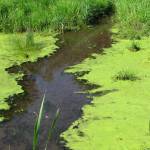Avoid Risks to Horses from Blue-Green Algae

In the past few months, you’ve fertilized your pastures, spread composted manure on them, and watched the grass grow greener and taller. Your next-door neighbor has fertilized his soybean field, and his crop looks great. However, you’re concerned because your horses drink from a large pond that lies just downhill from both these fields, and the water has become discolored and scummy. You’ve also noticed a few dead fish floating on the surface. You saw an article about the dangers of blue-green algae, and the pond water does seem to have a greenish tint. Could that be the problem, and if so, are your horses at risk?
Blue-green algae, also known as cyanobacteria, can produce toxins that are hazardous to horses, cattle, deer, birds, dogs, and humans. When nutrients from fertilizer or manure are washed into a pond or lake, an algal bloom can occur. This overgrowth of cyanobacteria typically occurs during a period of hot, sunny weather when the water is warm and growth of algae is encouraged. The bloom may last several weeks as the algae multiply and then die and decompose. The cycle depletes oxygen levels in the water, sometimes leading to significant fish kills.
Toxins produced by the algae are harmful to animals drinking the contaminated water. Microsystin, one of the toxins, affects the gastrointestinal tract, causing colic and diarrhea in horses. In severe cases, liver damage from the toxin can be fatal, especially in dogs that seem to be more susceptible than some other animals. Dogs that drink from or swim in the scummy water are at risk. The toxin is still active in dried scum along the banks of a pond. Vomiting may be the first sign of a problem, and the dog should be seen by a veterinarian as soon as possible for treatment. Early intervention can help to prevent serious illness and liver damage.
Humans may also experience gastrointestinal and liver problems after exposure to blue-green algae, but because they usually don’t drink water from contaminated ponds or lakes, this serious reaction is not common. Skin rashes, inflammation of the eyes and nasal passages, coughing, and sneezing are more usual signs of exposure after swimming or water-skiing in affected bodies of water. To avoid skin irritation, pet owners should wear protective gloves when they handle animals that have been exposed to blue-green algae.
To minimize the risks from algal blooms, limit use of agricultural fertilizers and chemicals in areas that drain into lakes or ponds. Spread manure and compost on flatter areas rather than on sloping land close to water. Avoid using ponds and lakes as sources of drinking water for horses, at least during summer months. Call a veterinarian if horses show signs of colic or diarrhea, especially if you suspect they have had access to contaminated water. Check with the local agricultural extension agent for suggestions on minimizing algae growth and guidelines for fertilizer use.








